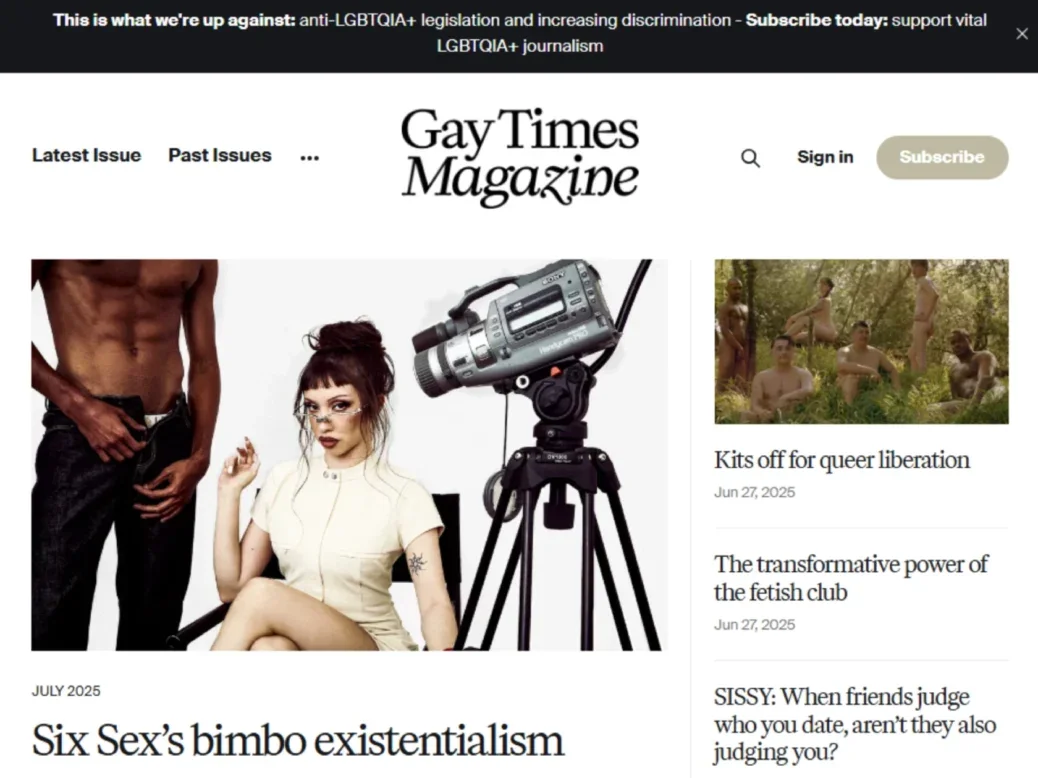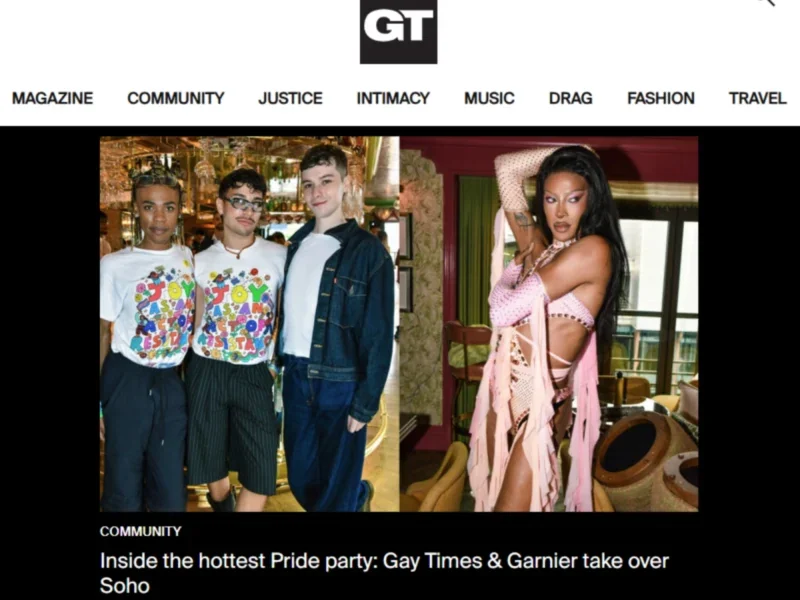
Gay Times is combating the loss of 80% of its advertisers by bringing in readers as investors and doubling down on subscriptions.
In a community investment initiative that ended last week, Gay Times raised £152,322 from 363 investors who bought shares and became co-owners of the brand.
The UK-based title said the move was triggered by advertisers moving away from spending with LGBTQ+ and other diverse brands over the past year.
Gay Times Group moved into a loss-making period last year as a result but is now growing revenue and profitable again as of this summer, chief executive Tag Warner told Press Gazette.
The UK-based LGBTQ+ media brand was launched in 1984 and had a monthly print magazine until its closure in 2021. It now has a free website branded as GT which is focused on lifestyle and entertainment content, and a subscription-based sister site called Gay Times Magazine.
Warner said advertising began to fall off months before Donald Trump’s election in November last year. It started in the US, a large market for Gay Times, before also hitting in the UK.
He said they had seen the “pace pick up of a very well-funded movement… primarily funded from the Super PACs (political action committees) in the US to lobby organisations to divest from diversity generally”.
He also cited the “go woke go broke” idea and the backlash to company DEI (diversity, equity and inclusion) policies that picked up speed further after Trump took office.
Eight in ten Gay Times advertisers pulled out – even some whose campaigns were ready and paid for but they did not want them to run anymore.
Warner described it as “good old-fashioned discrimination” as “there’s not actually a business case to it,” saying Gay Times had always been told by agencies that its campaigns got a “great ROI [return on investment]” and “overindexed against the major players”.
It was also “fear” on the part of brands that they would be “dragged” for working with diverse organisations, he added, although he noted that some brands have “shown up like always and haven’t been criticised” this year.
Gay Times had built a “huge” team to deliver its brand partnerships, which were bringing in the majority of revenue, and redundancies were carried out last year to “right size” the business.
Work on in-person activations and events for brands was less affected, with Warner saying there was a perceived lower risk “because if you have a digital campaign which is basically all over the internet, there was concern then that that might travel to different audiences, and then create negative discourse for the brand, but also for the community”. This month Gay Times held a Pride party in London with skincare brand Garnier.
Gay Times community investment: Start of a ‘long-term journey’
The community investment initiative launched in May, explaining to the audience that they were “transitioning to a subscription-first, community-owned model focused on impact journalism, culture, and global storytelling — with added talent, potential brand pipeline & plans for exploring brand licensing opportunities”.
The share price was £16.66 and the company valuation beforehand was £25m, according to Crowdcube. Investors were offered various tiers based on the amount invested, with perks including complimentary Gay Times subscriptions, enamel pins, cover prints, coffee table books, a “black card” giving access to Gay Times events, and private dinners.
Warner said the aim was to get around 200 people investing in Gay Times, meaning they beat their target. The money raised does not represent a sizeable chunk of revenue but, Warner said, represents the start of a “long-term journey”.
Warner said the success of the campaign showed “the kind of times that we’re in but also how people want to support media that speaks to them, and they have that very personal and emotional relationship with”.
He said that beyond the shareholding, it has “given us this opportunity to reconsider how we interact with our audience. I think that’s helped us culturally shift to being an organisation that is putting the audience much more closely at the centre, which, of course, I think we felt like we’ve always done a content strategy, but maybe not as a whole business.”
The money will go directly towards journalism, Warner said, teasing that new editorial hires are coming soon to cover “more rigorous, integrity-based journalism that we think is really needed right now”.
He said this will be a “nice moment for us because of course we’ve just seen consistent cutback after consistent cutback in journalism and media so to be able to go on this journey now of actually being able to employ people from our community that are in journalism is really exciting”.
Gay Times ‘doubling down on more serious journalism’
Gay Times first launched a print and digital subscription bundle, Gay Times+, during the Covid-19 pandemic which Warner described as “really successful, and we learned loads from that, and I was really pleased we did that because we didn’t actually have a lot of experience as an organisation on how to do that”.
After the print magazine closed, subscribers were moved to digital subscriptions but the focus internally was on growing the brand’s overall audience through social media.

Gay Times told its potential community investors that it has gone from a magazine circulation of 161,000 in 2021 to having a global digital audience of 72.9 million people.
But Warner said now is the right time to build a “really robust subscription offering” taking lessons they have learned about “creating value… you can’t just be replicating the content that’s out there that’s already available. You have to have a new perspective or angle.”
He said they will be “doubling down on much more serious journalism, political journalism, especially out of the US”. Stories about access to healthcare are already proving a key area of interest.
Warner added that the intent is to build the subscription product around the audience and what they respond to “rather than us trying to take what we’ve always been doing and put a paywall behind it”.
Subscription site magazine.gaytimes.com, which has still published monthly digital issues since the print magazine closed, will be the space for this new journalism. Warner noted that it has more of a print-style aesthetic and has previously kept to a monthly, then recently a weekly, cadence of new content which will now gradually scale up to daily.
Meanwhile gaytimes.com will continue to be freely available, providing the entertainment and culture stories preferred by the more social-driven audience and being the space for brand partnerships.
Warner said focusing on the subscription product will also help the brand be resilient as a “destination brand” in the face of falling traffic referrals from platforms like Google with the introduction of AI Overviews which Gay Times has already seen affecting clickthroughs like many other publishers.
[Read more: How Google AI Overviews is fuelling zero-click searches for top publishers]
Gay Times also has a talent agency called Wax Talent, founded in May 2024, representing names like fashion designer Daniel Fletcher, Australian drag queen Courtney Act and Australian footballer Josh Cavallo.
Warner said the talent agency side of the business has “held up” compared to the challenging brand advertising on Gay Times itself.
They are embracing that shift: where advertising relationships were generally previously with Gay Times, they are now working directly with brands on creative and brand campaigns through Wax.
“I think that’s going to do a lot of good for us, because I think it will allow Gay Times from an editorial and press angle to go into that slightly more gritty place, and we know that maybe advertisers can be a bit hesitant with that,” Warner said, adding that Wax might be “a bit more approachable for brands”.
Email pged@pressgazette.co.uk to point out mistakes, provide story tips or send in a letter for publication on our "Letters Page" blog
